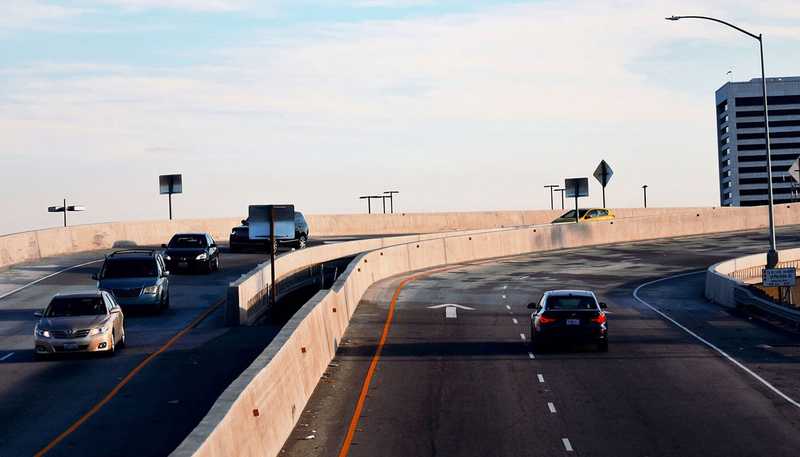Los Angeles Auto Accidents Lawyer
Auto Accidents
Los Angeles is a city famous for many things — and traffic is close to the top of that list. The Los Angeles metro area is home to more than 13 million people, and the city’s roads and freeways serve as vital arteries for daily commutes and commerce.
This also means that L.A. roads and freeways are very, very busy. The city ranks number one in the U.S. in terms of traffic density and congestion — and witnesses more than 50,000 traffic collisions during most years.
Busy streets lead to auto collisions — and serious injury and death.
Los Angeles Auto Accidents: By the Numbers
In 2018, there were nearly 60,000 traffic accidents on L.A. roads. Those accidents were responsible for 240 deaths and thousands of injuries. In addition to those incidents, another 127 pedestrians were killed — the second highest total of the last 15 years.
Though living in L.A. has many wonderful aspects, traffic certainly isn’t among them. Local roads are not only dangerous; they’re stress inducing.
In order to stay both physically and emotionally healthy, it’s imperative to minimize the risks associated with the road. Yet even the most cautious person often falls victim to the negligence of another driver.
What to Do in the Event of an Auto Accident
If you’ve been in a traffic collision, it’s critically important to follow some smart safety protocols. Following the incident, take these important steps:
- Move out of oncoming traffic to a safe location
- Seek medical assistance if necessary
- Take videos and photos of any damage or injuries
- Ask for witness contact information
- Seek medical attention if necessary
- If hurt, keep track of all your medical bills, lost wages, expenses etc.
- Contact an experienced Los Angeles auto accident attorney
Auto Accident FAQs
The following frequently asked questions (“FAQs”) are not offered or intended as legal advice. If you have legal questions, you should always consult an attorney:
What if I can’t afford California auto insurance?
If you cannot afford liability insurance, you may be eligible for the California Low Cost Automobile Insurance Program. Additional information is available at https://mylowcostauto.com/coverage or by calling 1-866-602-8861.
What is California uninsured motorist coverage?
Uninsured motorist coverage protects you if you sustain injuries or property damage in an auto accident caused by someone else who does not have insurance. When this occurs, your own insurance company will compensate you for your injuries or property damage up to the amount of coverage you purchased from your insurance company.
What is California underinsured motorist coverage?
Underinsured motorist coverage protects you if you sustain injuries or property damage in an auto accident caused by someone else who does not have enough insurance to compensate you. When this occurs, you must first obtain all available policy limits from the at-fault driver’s insurance company. Once this happens, you must then open a claim through your own insurance company to obtain compensation for the remainder of your damages up to the amount of coverage you purchased from your insurance company.
What Is Medical Payments Coverage?
Medical payments coverage is part of an auto insurance policy. It may help pay your or your passengers’ medical expenses if you are injured in a car accident, regardless of who caused the accident.
What is the minimum amount of car insurance required in California?
California requires drivers to carry at least the following auto insurance coverages: Bodily injury liability coverage: $15,000 per person / $30,000 per accident minimum. Property damage liability coverage: $5,000 minimum.
Should I carry more than minimum car insurance coverage?
Yes! If finances permit, it is always a good idea to carry more than minimum coverage. Why? If you cause an accident and your insurance doesn’t cover the injured persons damages, that person has the right to sue you personally for the difference.
Often, the cost to increase coverage is minimal. It is always a good idea to inquire with your carrier about the cost to increase your policy limits.
Is California a no-fault car accident state?
No, California is not a no-fault state for auto insurance. It is one of the 38 states in the country where the person who causes a car accident has to pay for the damage and injuries. When an accident occurs, the police determine who’s at fault. Then, to collect payment for their losses, victims must file a claim with the at-fault driver’s insurance company. Liability insurance is the type of insurance that pays victims’ claims, and all drivers in California are required to carry it.
Can I drive in California with a foreign driver’s license?
If you are a visitor in California over 18 and have a valid driver license from your home country, you may drive in this state without getting a California driver license as long as your out-of-country license remains valid.
If I move from out-of-sate do I have to get a California driver’s license?
If you become a California resident, you must get a California driver license within 10 days. Residency is established by voting in a California election, paying resident tuition, filing for a homeowner’s property tax exemption, or any other privilege or benefit not ordinarily extended to nonresidents.
At what age can I get a driver’s license in California?
You can obtain a driver’s license at the age of 16 in California, but only after completing both driver education and driver training courses. Additionally, drivers must have had a California instruction permit or an instruction permit from another state for at least 6 months prior to obtaining a license.
How many points on my California driver’s license can I get before it is suspended?
A California licensed driver can not incur more than 4 points in a 1-year period, 6 points in a 2 year period and 8 points in a 3 year period.
What does BAC mean?
BAC stands for blood alcohol content. It is the percent of alcohol in a person’s blood stream.
What is the legal limit (BAC) in California?
The blood alcohol limit for operating a motor vehicle or a boat in California is 0.08%. For commercial drivers such as semi-trucks, the legal limit is 0.04%. For persons under the age of 21, the legal limit is 0.01%.
Can I refuse a field sobriety test?
Yes, in California you have the right to refuse a field sobriety test. However, you may be required to take either a breath or blood test. If your refuse one of these tests, you may lose your license.
Can I refuse a blood test for DUI?
No. Although you can refuse a field sobriety test, the refusal to take a blood test may result in the automatic suspension of your license for one year.
Am I required to stop if I’m in a car accident?
Yes. If you are involved in an accident in California, no matter how minor, you must stop and give your identifying information to all other drivers involved. Failure to do so may result in a hit and run criminal charge being filed against you.
What is a Form SR-1 in California?
A California SR-1 form is a report that you submit to the DMV, placing the DMV on notice of a traffic accident. Submission is mandatory if the accident results in any injury or property damage over $1000.
Am I required to submit a California SR-1 form?
California law requires all drivers involved in an accident resulting in any injury, or property damage over $1000 to submit an SR-1 form to the DMV. You must do so within 10 days of the accident. If you do not submit the form, your license may be suspended.
For a link to the DMV’s SR-1 form, click here: https://www.dmv.ca.gov/portal/uploads/2020/05/sr1.pdf
Should I call the police if I am in a traffic accident?
Yes! No matter how minor the accident, it is always a good idea to call the police. Although in Los Angeles County police will rarely come to the scene unless there are injuries and/or major property damage.
It is a good idea to at least attempt to get police to the scene and write a report. Doing so ensures that all driver information is obtained, and a determination of fault is made.
What if the person who causes my car accident has no insurance?
If you’re involved in an accident caused by someone else and that person does not have auto insurance, you must either sue that person to recover money, or file a claim with your insurance company if you have uninsured motorist coverage.
What if the person who causes my accident doesn’t have enough insurance?
You must either sue the driver directly or if you have underinsured motorist coverage, file a claim with your insurance company for the difference.
Who pays for my injuries in a car accident?
If you are responsible for the accident, you must pay for your own injuries. If another driver is responsible for your injuries their insurance company will pay for your injuries. If the responsible driver does not have enough insurance to cover your damages, you can either sue the them for the difference or, if you have underinsured motorist coverage you can file a claim with your insurance company for the difference.
Do I have to have my car fixed at a specific body shop?
No. Under California law, you have the right to take your vehicle to the body shop of your choice. If another driver is at fault, and if that driver has auto insurance, the insurance company must honor your choice to get the vehicle fixed anywhere you choose.
Can my insurance company cancel my policy?
According to the California Insurance Code, cancellation of a policy shall be effective only if it is based on one or more of the following reasons:
(1) Nonpayment of premium.
(2) The driver’s license or motor vehicle registration of the named insured or of any other operator who either resides in the same household or customarily operates an automobile insured under the policy has been under suspension or revocation during the policy period or, if the policy is a renewal, during its policy period or the 180 days immediately preceding its effective date.
(3) Discovery of fraud by the named insured in pursuing a claim under the policy provided the insurer does not rescind the policy.
(4) Discovery of material misrepresentation of any of the following information concerning the named insured or any resident of the same household who customarily operates an automobile insured under the policy:
(A) Safety record.
(B) Annual miles driven in prior years.
(C) Number of years of driving experience.
(D) Record of prior automobile insurance claims, if any.
(E) Any other factor found by the commissioner to have a substantial relationship to the risk of loss.
Any insured who negligently misrepresents information described in this paragraph may avoid cancellation by furnishing corrected information to the insurer within 20 days after receiving notice of cancellation and agreeing to pay any difference in premium for the policy period in which the information remained undisclosed.
- (5) A substantial increase in the hazard insured against.
- (b) Modification of automobile physical damage coverage by the inclusion of a deductible not exceeding one hundred dollars ($100) shall not be deemed a cancellation of the coverage or of the policy.
What is a declarations page?
An auto declarations page is issued by an insurance company listing the amount of their coverage limits. This will include line items listing the dollar amount for bodily injury, uninsured motorist, medical payments, car rental and comprehensive coverage.
Insured’s can ordinarily obtain this page upon request from their insurer either online or by phone.
Does my health insurance have a right to be repaid if I’m in a car accident?
This all depends on the language contained in your health insurance policy. Ordinarily, most companies have a right of reimbursement for all medical treatment if you receive money from another party as the result of an auto accident.
If the accident is your fault, or if you do not obtain money from another party, your health care provider is not entitled to reimbursement.
If I’m a Medicare recipient to I have to report an auto accident to the government?
Yes, by law Medicare MUST be notified whenever a Medicare recipient opens any claim against an at-fault driver. See attached link for more information:
Does Medicare have a right to be reimbursed if I receive money from an at-fault driver?
Yes, Medicare has a right of reimbursement for all benefits that relate to the auto accident. By law, you MUST report any third-party claims to Medicare.
If I’m a Medi-Cal recipient to I have to report an auto accident to the government?
Yes, by law these types of claims must be reported. For more information please see: https://www.dhcs.ca.gov/services/Pages/TPLRD_PersonalInjuryProgram.aspx
Does Medi-Cal have a right to be reimbursed if I receive money from an at-fault driver?
Yes, please see the following FAQ: https://www.dhcs.ca.gov/services/Pages/TPLRD_PIP_FAQ.aspx
Does an Umbrella policy cover car accidents?
Ordinarily, if an at-fault driver has an umbrella policy, it will cover car accidents in excess of that person’s auto insurance policy. However, each policy is different, and it all depends on the language contained in the policy.
Does a homeowner’s policy cover car accidents?
Ordinarily, no. Your homeowner’s insurance policy only covers accidental injuries that occur on your property or that are caused by you or a family member.
How much Is Uber’s insurance limits in California?
If an Uber Driver is responsible for an accident in which you are involved, either as a passenger in the Uber/Lyft, or if you are in another car and hit by an Uber/Lyft, California mandates a $1 million dollar personal injury policy limit.
Can I lose my driver’s license for unpaid parking tickets in California?
Since 2017, California will not suspend your license if you have unpaid parking tickets. See: https://www.latimes.com/local/lanow/la-me-ln-driver-license-fees-20170629-story.html
What are the statistics on California car accident deaths?
The most recently published results from the California Office of Traffic Safety are:
Overall
- Traffic fatalities decreased 8.3% from 3,884 in 2017 to 3,563 in 2018.
- The 2017 Mileage Death Rate (MDR) – fatalities per 100 million miles traveled – is 1.13.
Alcohol-Impaired Driving
- Alcohol-impaired driving fatalities (fatalities in crashes involving a driver or motorcycle rider with a blood alcohol concentration, or BAC, of 0.08 or higher) decreased 6.8% from 1,147 in 2017 to 1,069 in 2018.
Drug-Impaired Driving
- In 2018, 42% of all drivers killed in motor vehicle crashes, who were tested, tested positive for legal and/ or illegal drugs.
Occupant Protection
- Unrestrained passenger vehicle occupant fatalities in all seating positions decreased 4.3% from 625 in 2017 to 598 in 2018.
Motorcycle Safety
Motorcycle fatalities decreased 15.57% from 578 in 2017 to 488 in 2018.
Motorcyclist deaths from not wearing a helmet decreased 33% from 45 in 2017 to 30 in 2018.
Teen Safety
Teen motor vehicle fatalities (age 16-19) increased 21.4% from 168 in 2017 to 204 in 2018.
Teen Driver fatalities (age 16-19) decreased 15% from 106 in 2017 to 90 in 2018.
Pedestrian and Bicycle Safety
Pedestrian fatalities decreased 5% from 940 in 2017 to 893 in 2018.
Pedestrian fatalities age 65 and older increased from 194 in 2017 to 195 in 2018.
Bicycle fatalities increased 6.89% from 145 in 2017 to 155 in 2018.
What are the most dangerous intersections in Los Angeles County?
According to Crosstown LA, a non-profit organization partnered with USC Annenberg, the following is a list of the most dangerous intersections in Los Angeles:
- Van Nuys: Sherman Way & Sepulveda Blvd.
- Vermont Knolls: Manchester Ave. & Figueroa St.
- Van Nuys: Burbank Blvd. & Sepulveda Blvd.
- Panorama City: Van Nuys Blvd. & Roscoe Blvd.
- Valley Glen: Victory Blvd. & Coldwater Canyon Ave.
- Northridge: Tampa Ave. & Nordhoff St.
- Van Nuys: Sherman Way & Woodman Ave.
- Valley Glen: Sherman Way & Coldwater Canyon Ave.
- Vermont Vista: Imperial Highway & Figueroa St.
- Lake Balboa: Balboa Blvd. & Victory Blvd.
- West Hills: Fallbrook Ave. & Victory Blvd.
- Valley Glen: Sherman Way & Whitsett Ave.
- Porter Ranch: Devonshire St. & Reseda Blvd.
- Van Nuys: Sepulveda Blvd. & Victory Blvd.
- Broadway- Manchester: Imperial Highway & Main St.
- Van Nuys: Sherman Way & Kester Ave.
- Panorama City: Van Nuys & Arminta St.
- Winnetka: Saticoy St. & Winnetka Ave.
- Van Nuys: Sepulveda Blvd. & Erwin St.
- Northridge: Tampa St. & Plummer St.
What are the most dangerous highways in California?
- 1-5 / 192 Fatalities
- US-101 / 139 Fatalities
- SR-99 / 110 Fatalities
Finding the Right Auto Accident Lawyer
If you’ve been injured in an auto accident it is crucial to hire an experienced attorney with the knowledge and skill to obtain maximum compensation. Craig Charles Law has a long track record of fighting on behalf of clients injured in car accidents, thus ensuring the best possible outcome for you.
Craig Charles Law has offices located in West Hollywood, El Segundo and San Diego to serve the needs of clients throughout Southern California. We are a gay friendly, LGBTQIA affirming law practice. Call Craig Charles Law today for a free, no obligation consult at 424-343-0660





